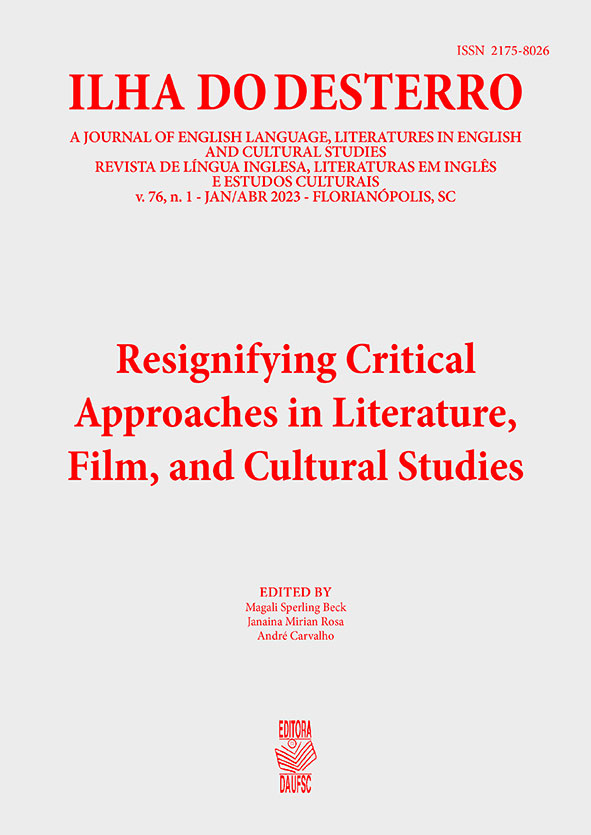Be Brave, live: reviewing Buffy's journey in Buffy The Vampire Slayer from Final Girl to Heroine twenty-five years later
DOI:
https://doi.org/10.5007/2175-8026.2023.e88363Palavras-chave:
Buffy the Vampire Slayer,, TV shows, feminism, final girl, monomythResumo
O presente trabalho discute o programa de TV americano Buffy The Vampire Slayer reavaliando sua protagonista, Buffy Summers, vinte e cinco anos após sua primeira transmissão. Como uma adolescente transformada em caçadora de vampiros/demônios, Buffy sofre mudanças significativas em relação ao seu chamado de caçadora. Relutante no início, ela aceita suas responsabilidades mais tarde na série, em um movimento que ecoa a definição de monomito de Joseph Campbell. Os autores se propõem a discutir as mudanças de Buffy ao longo da série, enfatizando os principais momentos narrativos, a fim de ilustrar como a personagem evolui do que poderia ser percebido como um arquétipo semelhante à ‘final girl’ para uma heroína (feminista?) Além disso, os autores comentam sobre as alegações de abuso contra o criador de Buffy, Joss Whedon, e como elas se relacionam com o legado da série vinte e cinco anos depois.
Referências
Canavan, Gerry. “Whedon Studies after Whedon: A Conversation with Sherryl Vint.” Slayage: The Journal of Whedon Studies, vol.16, no. 2, Issue 48, Summer/Fall, 2018, pp. 176-192.
Campbell, Joseph. The Hero with a Thousand Faces. Princeton UP, 2004.
Clover, Carol J. Men, Women and Chainsaws: Gender in the Modern Horror Film. Princeton UP, 1992.
Clover, Carol J. “Her Body, Himself: Gender in the Slasher Film.” Representations, no. 20, Special Issue: Misogyny, Misandry, and Misanthropy, 1987, pp. 187-228. www.jstor.org/stable/2928507.
Ellwood, Robert. The Politics of Myth: A Study of C. G. Jung, Mircea Eliade, and Joseph Campbell. State U of New York P, 1999.
Frankel, Valerie Estelle. From Girl to Goddess: The Heroine’s Journey through Myth and Legend. McFarland & Company, Inc., 2010.
Murdock, Maureen. The Heroine’s Journey: Woman’s Quest for Wholeness. Shambhala Publications, 1990.
Wilcox, Rhonda. Why Buffy Matters: The Art of Buffy the Vampire Slayer. I. B. Taurus, 2005.
Wilcox, Rhonda. “Ten on Twenty: Personal Reflections upon Twenty Years into Buffy the Vampire Slayer.” Slayage: The Journal of Whedon Studies, vol. 16, no. 1, Winter/Spring, 2018, pp. 1-15.
Downloads
Publicado
Edição
Seção
Licença
Copyright (c) 2023 Yasmim Pereira Yonekura, Vitor Henrique de Souza

Este trabalho está licenciado sob uma licença Creative Commons Attribution 4.0 International License.
A revista Ilha do Desterro publica artigos e resenhas inéditos, referentes as áreas de Inglês, Literaturas em Língua Inglesa e Estudos Culturais. Publica volumes mistos e/ou temáticos, com artigos e resenhas em inglês e português.
Autores mantém os direitos autorais e concedem à revista o direito de primeira publicação, com o trabalho simultaneamente licenciado sob a Licença Creative Commons Attribution que permite o compartilhamento do trabalho com reconhecimento da autoria e publicação inicial nesta revista.

This work is licensed under a Creative Commons Attribution 4.0 International License.



